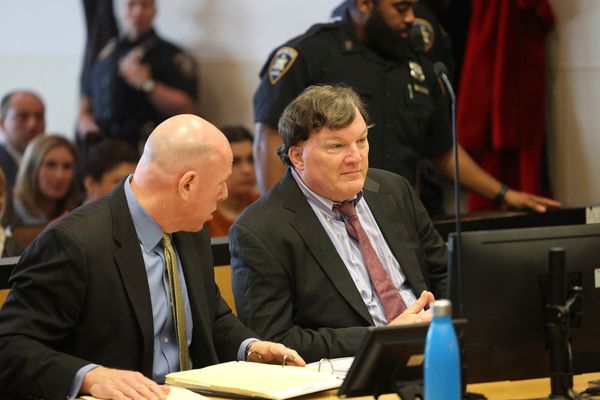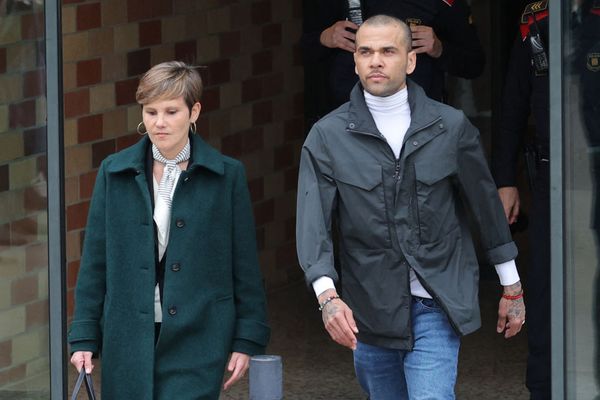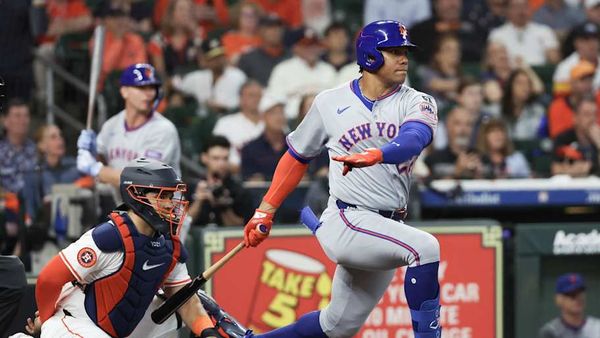Warning: This story contains images depicting nudity.
"Start your day with a good breakfast together," reads the title of one of Pixy Liao's photographs.
In it, Liao sits at a kitchen table eating a strategically placed papaya. (It's giving Samantha does-nude-Valentine's-Day-sushi-dinner, for any Sex and the City fans.)
It's the kind of tongue-in-cheek relationship advice the Chinese multidisciplinary artist delivers through her ongoing photo project Experimental Relationship: a series of staged self-portraits of Liao with Takahiro Morooka, aka Moro: a Japanese musician and artist – and Liao's partner of 17 years.
The photos are variously erotic, tender, playful — and captioned with pithy one-liners and double entendres (including the series' title).
Experimental Relationship has proved hugely popular with audiences; works from the series have been exhibited in Europe, North America and the Asia-Pacific, including Australia at the National Gallery of Australia, in 2020, and Sydney's temple of postmillennial Chinese art, White Rabbit Gallery, in 2022.
This month, Australians can see Liao's work in Sydney at the Powerhouse Museum, Melbourne at the Centre for Contemporary Photography, and Perth at the Art Gallery of Western Australia.
A different kind of 'muse'
In front of the camera, Liao assumes a dominant role with Moro as her submissive.
It's a dynamic that grew organically from her romantic partnership with Moro, who is five years her junior.
"Because I grew up in China, I always had this doubt [about gender roles]. 'Why do men have to act one way and women have to act the other way? Why do we always have to date older men?' But I never had an answer for that, and I didn't know what the alternative options [were] for me," Liao says.
"When I met Moro, I suddenly realised there can be another way; maybe I can try a way that I like."
With that, Moro became Liao's muse.
Traditionally, the role of the muse in art is to inspire the artist. But the artist-muse relationship is an historically gendered one.
The concept dates back to ancient Greek mythology. The 'Muses' were the nine daughters of Zeus and Mnemosyne and considered goddesses of art, science and literature. They were also the lovers of Apollo, the god of the arts.
Writing about the feminine muse, Germaine Greer put it this way: "A muse is anything but a paid model. The muse in her purest aspect is the feminine part of the male artist."
Liao's photography blithely up-ends this dynamic.
Meet-cute
Before she took up photography full-time, Liao worked as a graphic designer in her hometown of Shanghai. Disillusioned with her job and craving greater creative autonomy, she quit in 2005 and moved to the US to study a Master of Fine Arts in photography at the University of Memphis (UoM).
That's where she met Moro. He was there on exchange from the University of Alabama, studying music.
Speaking to ABC Arts over Zoom, Liao lights up when asked about their meet-cute: "That's a story I like to tell!
"On the first day of school, there was an international student orientation. I spotted him in a group and he was introducing himself to everybody, [saying] 'I'm here to study jazz.'"
Liao swoons; Moro, who is sitting beside her, blushes.
"[I thought], here is this beautiful young musician who is really my type, and I remembered him from that first day of school and always hoped I [would] see him again," she says.
A year later, Liao found Moro at an art event on campus.
"I was like, 'I'm a photographer. Can I talk to you? Can I take photos of you?' That's how we met," she recalls, laughing.
Moro nods: "I liked her too, the first time I saw her. I was trying to talk to her but I was too shy."
Liao continues: "I was just pretending I had a lot of photo assignments. I [would] always ask him for help, [saying], 'I need to do another photo. Can you model for me again?'
"I created many opportunities for myself."
'A game we play'
The inspiration for Experimental Relationship came a year into their relationship, in 2007, while they were living in Memphis. Liao was working on a photo project that involved staging crime scenes.
"I was asking Moro to play dead bodies. Sometimes he'd have to get naked and climb into a suitcase," Liao says.
"At first, I thought this was completely normal, for a boyfriend [to be] helping his girlfriend with photos, but then I realised: This is not a normal boyfriend."
Liao's photos capture a sense of play. There is an easy intimacy between artist and muse that is palpable in their off-camera dynamic too.
"Moro was very supportive and very open to my photo ideas. I started thinking, 'There must be something special about our relationship,'" she says.
"At the same time, I [felt] like people didn't understand it and I wanted to show how natural it is for us to be together, so I started taking photos of us together."
After graduating from UoM, the pair moved to Brooklyn, New York, where they have lived for the past 14 years. Most of the series has been shot in the three apartments they've shared during that time.
Liao was very particular about planning shoots in the early years of their collaboration, but her approach is "looser" now, she says.
"It's more like a game that we play because we [have] collaborated for a very long time and Moro really understands me. Sometimes he will give me a very good idea during the photo shoot, so it's half [what I've] imagined and half improvised."
Subverting expectations
Much of Liao's work is subversive. It's as if she's winking at the audience; letting us in on a joke. But audiences didn't understand Liao's humour when she first started exhibiting, she says.
"Especially in the US, and [being from an] Asian minority – people see your work and think, 'Here's this Asian couple doing Asian things.' So whatever we'd do, [the audience] felt very remote.
"Then around 2015, 2016, we started to have this movement of MeToo and people [paying] more attention to female voices. Then people started to find a way to talk about my work."
While Liao has exhibited widely, her work has resonated most strongly with young Chinese women, she says.
"Because it's not what they're used to seeing. In China, [the general public] usually thinks there is a right way to do things; a right way for a woman or a man to be.
"I feel like people respond to my [photos] mainly based on their values. They are [asking], 'Does this type of relationship match, or is it accepted by my values?'
"There's a big difference with younger women, especially in China. They really understand my work compared to the [older] generations."
The series also captures what Liao describes as a "love-hate relationship" — in part, a facetious reference to a socialised rivalry between the pair based on Liao's Chinese heritage and Moro's Japanese heritage.
Liao explains: "In a relationship, it's not always nice. A lot of the time, there's competition going on and sometimes you really dislike each other.
"But I generally like you," she says, looking at Moro.
"Generally?!" he exclaims.
Liao twinkles at this reaction, then continues: "There's always that negative side, but I think that's also part of what really attracts me in a relationship too.
"Besides being [a] partner and collaborator, you're also rivals to each other in a way. I think that's really interesting."
Liao plans to continue the series – she hopes, into her old age.
"I'll do it as long as Moro lets me take photographs and as long as he doesn't break up with me," says Liao.
"Never!" Moro chirps back.
Experimental Relationship runs at Centre for Contemporary Photography, Melbourne from April 21 to July 9. I have not loved (enough or worked) runs at AGWA, Perth until April 23.







